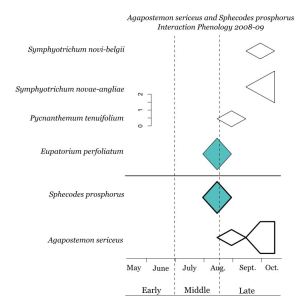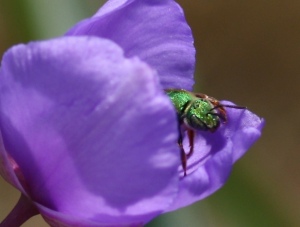You can check out the full manuscript (Supporting crop pollinators with floral resources: network-based phenological matching), complete with 8 additional figures here. It is an open access journal, freely available to anyone!
Category Archives: Uncategorized
About
This website is designed to provide supplemental information to the paper “Supporting crop pollinators with floral resources: network-based phenological matching” in the journal Ecology and Evolution (an open access journal). We will provide figures detailing the interaction phenology of bees collected in a floral provisioning experiment in central Pennsylvania. We hope that this site is useful to those interested in supporting native and domesticated bee species in agroecosystems.
Finished with bee phenologies
All of the bee interaction phenologies have now been posted, some lumped together in genera or other groupings. If you have a particular interest in one species that was lumped with others, if you would like to see the interaction phenology of a particular plant species, or if you have other data that you would like us to make a figure out of, please leave a comment below.
You can use the search bar to find your species of interest.
Also, please note that Bombus impatiens, Apis mellifera, and the genus Osmia were all represented in figures in the manuscript (publication pending), and so are omitted from this website.
Contact us with any questions!
Pseudopanurgus andrenoides and Hoplitis producta
Anthophora bomboides, Ceratina strenua, and Peponapis pruinosa
Some of the less common remaining Apidae species, which are lumped together here because they visited the habitat with low frequency.

Anthophora bomboides (pink), Ceratina strenua (yellow), and Peponapis pruinosa (teal). You can also compare this interaction phenology to that of the other, more common, Ceratina species.
Agapostemon sericeus and Sphecodes prosphorus

Little is known about Sphecodes prosphorus, but the Sphecodes are kleptoparasites of other Halictids (including this Agapostemon sericeus), so I thought it would be interesting to compare their phenologies. Their interactions segregated by plant species, so Sphecodes is in teal and Agapostemon is clear. You can also compare this phenology to Agapostemon virescens.
Xylocopa virginica
Halictus confusus and H. rubicundus
We covered the ubiquitous species, Halictus ligatus, in an earlier post. These two Halictus species were less common and are thus lumped together below. As always, if you are particularly interested in seeing one species independently, please contact the website administrator, or leave a comment.










